Newfoundland & Labrador
War Brides
Art Gallery
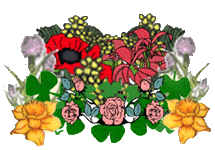

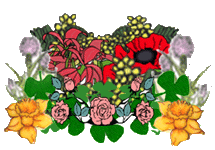
As part of The Gaelic Arts Festival at Grenfell College this site, dedicated to the Newfoundland and Labrador War Brides, was launched at the Corner Brook Museum and Archives. As part of the launch, the art installation "They came from an Ocean Away" was also installed at the museum. This, is to my knowledge, is the first time a museum in the province has allowed the interpretation of a time in history by an artist to be used as a display. Below you will see pictures and an explanation of the works.
Kathie, Joan and George for all their help
in having had made this artshow possiable.








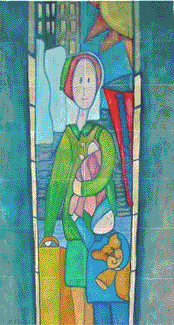
This was the piece that started this web site. It was 2006, the year of the war bride, but when I started to look for information it was almost nonexistent. Newfoundland was not part of Canada during the war and unlike the Canadian war brides, no precise tally of their arrival was recorded. To this day, no one knew how many war brides there were, who they were, where they came from, how they got here and how many were still alive. In my research I found a very important part of our history was slipping between the cracks of time and no one was taking notice. I had to start and find what information was out there on this important group of women.
"Reflections - The Arrival", by Jackie S. Alcock was my response.
Oil on Linoleum unframed 36" x 63"
A woman arriving in a new land with children in tow.
Everything she owned was on that dock.
The ship lay docked next to the wharf with just a little of the anchor line connecting it with the wharf. Would she be able to make a connection to this land.
The iceberg makes a cold separation from all the family she left to the family she now joined.
The building represented a land that, even war torn, had more advances than this new country.
The sun is hope and sometimes that is all one has.
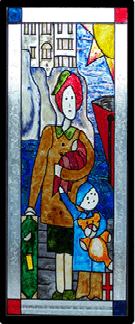
This was the piece I made
to see how a reflection would
look on a floor because the
above piece is a painted
reflection on a piece of
floor canvas.
Reflections on Glass
by Jackie S. Alcock
Gallery Glass on
Plexiglas glass
framed
17" x 35"
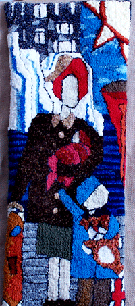
April 15, 2009
This is my latest piece,
It is the first large hooked rug I made.
Reflections on Glass
by Jackie S. Alcock
Hooked Rug
The Rooms Provincial Arts Gallery,
Government of Newfoundland and Labrador Collection, 2015
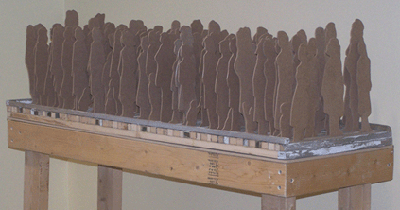
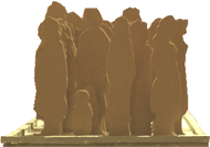
"The Wharf" by Jackie S. Alcock wood 16"w x 48L x about 43"h
This piece was a result of wondering about just how many war brides actually came to Newfoundland?
At this time I had gathered 120 names and that is how many 9",10" and 11" cut outs I made. I then made 30 children cut outs and a wharf to stand them on. I must thank Gerard Kelly, sculpture technician at Sir Wilfred Grenfell College, for helping me with the stand and suggesting I use old wood. My husband was very understanding when he saw that a rung of our fence was missing. My sculpture Professor Don Foulds RCA suggested that maybe this piece would best be left unpainted.
With over 360 names now gathered, I would now need three wharfs.
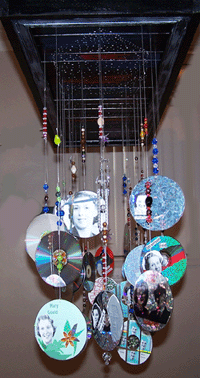
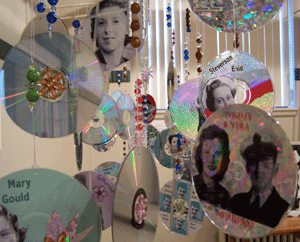
The Chimes of life
We are born. We live our lives and somewhere along the line the journey ends.
Chime one represents the sound we make coming into this world.
Chime two represents the sounds we make in life.
Chime three represents the memories we leave behind.
The jewels show that out of despair and loneliness these war brides brought beauty, light and sound into the lives they touched.
The CD’s were perfect for this piece. They were made, had a usefulness and are now unable to provide there full story. They are circular as in the circle of life and their function has changed as often does our direction in life. The CD’s reflect light giving of beautiful rays of light that last just seconds. Is that not what life is? Life is just a small light in the long hallway of history.
One’s life story is but a sound or a flash of memory in the minds and hearts of the people whose life we have touched.
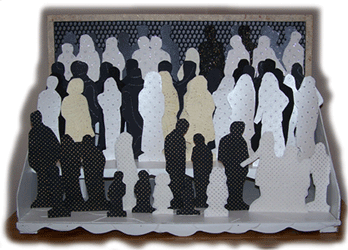
The Family Photo
At some time in a family history everyone comes together and the family photo is set in motion. This piece shows the moment before the photo is taken when everyone is up to something other then standing still and posing for that flash in history that is about to take place.
Just how many people are directly related to a war bride?
This piece shows the family of Mary Fletcher and George Sheppard. There is one paper doll for each of their daughters and their spouses, their one son, their grand-daughters and grand-sons and their spouses and the great grand-children up until 2008.
This piece is recycled from an old stand I made for a angel project, an oil painting and old posters.
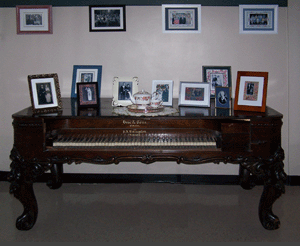
The Piano
The display room in the museum had this large and very heavy piano that would cost a lot to move. Therefore I decided to make the piano a part of the show. If you had owned a piano, it was in the parlor and it would have had the prized family photos on it. It might also have had some pieces of china like a tea pot on it. I have fond memories of china cups and many pots of tea.
Most of the frames are recycled from older artwork.
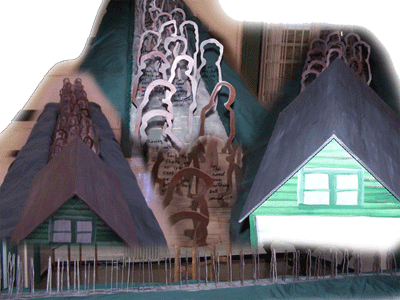
Memory Road
This piece came about when I was reading They Came from Across the Sea and other stories about war brides. I kept thinking, what was going through their minds when they landed here? There are 68 figures, one for every year a WWII war bride has been here. The figures are a frame with a phrase written on clear plastic.
In my work one thing leads to another. I was trying to put some lighting at the end of the road and ended up with a house that led to placing the plan of a veterans house at the end of the display. I grew up on Westmount, a co-op of twenty identical houses built for war veterans and their families. Today only one war bride remains on 'the hill' and only a few of the homes have passed into the hands of war vets families.
This piece is made out of my closet doors, a pile of left over wood that I recycled and I am seriously asking myself if this was such a good idea. It took about 300 pieces if wood to make the road and each had to be cut sanded and placed on the door. The wood frames were recycled from the The Wharf. The ascetate/plastic I had to buy and cut to fit the figures.
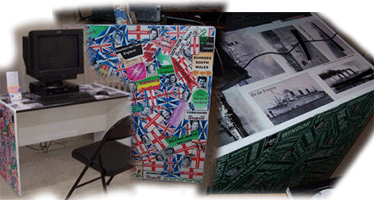
The Desk
As part of the show a computer is used to enable people to see and access the Newfoundland and Labrador War Bride Site that my husband and I have been working on for the last two years.
If we had a computer, we needed a desk.
1. I recycled a desk I had used in another project.
2. We made a trip to St. John’s and I I found myself reading all the road signs. I decided to make green and white road sign stickers, just like the provincial road signs for all the places that the war brides had settled in.
3. I collaged the green road sign stickers on the right side of the desk.
4. On the left, I made and placed stickers of the places the war brides had come from.
5. On the top of the desk, I collaged pictures of the ships they had traveled on to Newfoundland and Labrador.
6. The desk took on the look of a trunk. A trunk had once held all the worldly belongings of a war bride and now this desk/trunk holds all the information we know about our war brides.
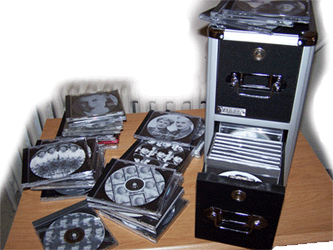
The Collection
I like to go though people's CD collections to see the art work on them. I had a lot of CD's that were scratched and unreadable. I also had old photo's of war brides. In my mind they seemed to be a perfect match. I could use the computer to update the photos, use the CD's as a canvas and use the CD cases as frames. It is as if the memory of the war bride is no longer accessible as the CD's are no longer retrievable. You end up with a 'hands on' art piece that is created to be picked up, handled and looked at. I am hoping to make one for every war bride photo that I receive and that each war bride will have her own CD cover.
For this project I have used recycled CD's and CD cases that I got from friends, bought those old CD's that no one wants at garage sales and even bought some new cases because cases don't seem to do well with frequent use and often get broken.

Full Circle
Drawer one:
In this part of the piece, I used old photos my mother had of her family in England and photos of land marks in Europe, the London Bridge and the Eiffel Tower.
I cut the pieces from the wood remaining from "The Wharf" piece.
Working in three layers I painted:
1. The first layer is white to show the happiness of being in love and a young bride following her husband half way around the world.
2. The second layer is painted gray to show the sadness of leaving family and friends behind.
3. The third layer is painted black for when the war bride arrives and realizes what she has come to, a place that is far more primitive then she ever thought possible.
Drawer two:
This part shows the war bride’s changing life and how she starts to adapt to her new home.
1. The first layer is black because the war bride, for a long time, is in shock.
2. The second layer is gray, as it is the time of letting go and accepting that this is her life. The war bride starts to adapt, times are hard, but she puts her family first.
3. Accepting this place is now her home, her life has come full circle.
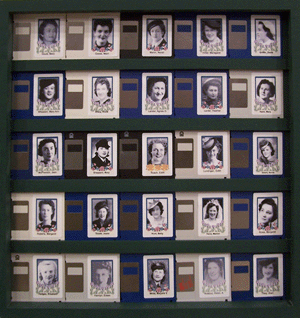
Lost and Found
When working with the photos of the war brides, I realized how many stories had been lost. Most of these were women’s voices we would never hear again and their knowledge was gone. At the time I was working on a piece dealing with floppy discs and how the knowledge on them was no longer attainable because the technology used to retrieve it was now obsolete.
I decided to print the pictures of the war brides and use them as the identification labels for the discs, merging the lost technology of the discs with the lost stories of the war brides. Together the discs and the photos give us a physical starting point to that which is lost, but with new technology and a generation who wants to know where they came from, we may be able to recover some of the information for future generations.
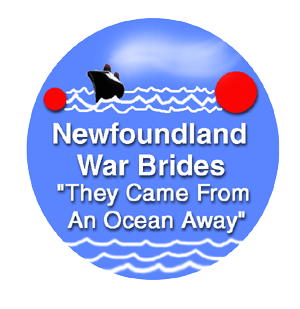 |
large red dot = Europe small red dot = Newfoundland ship = how the war brides arrived blue = ocean, distance, a different life waves = It was not easy |
This design is covered under copyright.
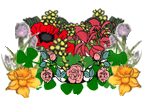

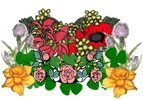
| Yearbook | References | Citizenship | Photo Album | Links |
| Submit Info | Contact Us | Comments |